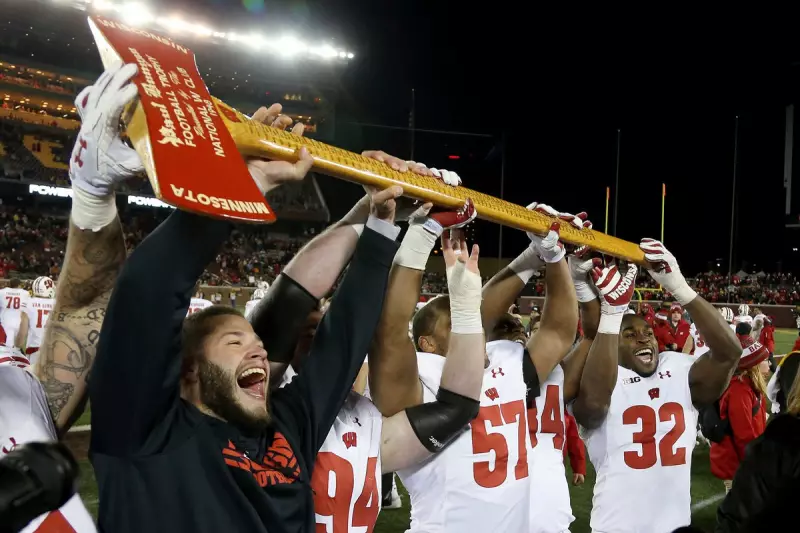
In the world of American college football, few traditions are as rich or as peculiar as the rivalry trophies fought for each season. These unique prizes, ranging from a six-foot axe to a bronze pig, represent some of the sport's most intense and historic grudge matches.
The Heart of the Tradition
One of the most celebrated rituals occurs in the bitter border-state rivalry between Minnesota and Wisconsin, the most-played series in major college football history. When the final whistle blows in the 135th edition of the Gophers-Badgers match, currently standing even at 63-63 with eight ties, the winning team performs a jubilant act of yardwork. Players sprint towards Paul Bunyan's Axe, hoisting the six-foot shaft triumphantly before aiming its head at a goalpost in a playful imitation of chopping down a tree. This axe has been awarded annually since 1948.
These travelling trophies remain one of the few constants in college football amidst an era of revenue sharing and the transfer portal. From small colleges to powerhouse programmes, they uniquely capture the attention of sports enthusiasts.
"It's a way for a community — certainly the students, alumni, fans and faculty, but even more casual fans — to get revved up for a football game," explained Christian Anderson, a University of South Carolina professor specialising in the history of higher education. "There are a lot of people who may not pay attention the whole season, and then the rivalry game comes and they're a passionate fan for one Saturday."
Historic Trophies of the Big Ten
Longstanding members of the Big Ten conference boast perhaps the richest collection of these unique prizes. The Little Brown Jug, which is paradoxically neither little nor brown, originated from the Michigan-Minnesota game in 1903. Wolverines coach Fielding Yost, fearing the Gophers might tamper with his team's water supply, instructed a student manager to purchase a jug. After a hard-fought tie where Minnesota fans stormed the pitch, the container was left behind. The Gophers formally returned it after Michigan won the next meeting in 1909.
Minnesota enjoyed more initial success with Floyd of Rosedale, a 98-pound bronze pig named after the state's governor in 1935. The governor proposed the trophy to his Iowa counterpart as a means to de-escalate tension between two fan bases with deep agricultural roots.
Other notable Big Ten trophies include:
- The Old Oaken Bucket, for which Indiana and Purdue compete. Found in disrepair on a local farm in 1925, it was believed to have been used by Confederate soldiers during the Civil War.
- The Old Brass Spittoon, contested by Indiana and Michigan State since 1950. This relic from the trading post era was purchased at an antique shop by an MSU student to add incentive to the game.
- The Illibuck Trophy, fought over by Illinois and Ohio State for a century. It is now a wooden turtle after an ill-fated attempt to award a real 16-pound snapping turtle to a student society.
- The Paul Bunyan Trophy, a four-foot wooden statue of the mythical lumberjack donated by the state's governor to mark Michigan State's entry into the conference. Michigan and Michigan State have battled for it since 1953.
National Treasures and Unusual Prizes
The NCAA has certified the Territorial Cup, contested by Arizona and Arizona State, as the oldest known rivalry trophy. It was awarded after their first meeting in 1899, though this small, silver-plated pitcher was missing for decades until its rediscovery in a storage area of a church near the ASU campus in 1983. The tradition of awarding the travelling trophy was formally reinstated in 2001.
A recurring theme among these trophies is their origin from the pre-industrial age. Nevada and UNLV play for the Fremont Cannon, a 545-pound replica of the cannon explorer John C. Frémont abandoned in a snowstorm during his 1844 trek through the state. Notre Dame and USC contest the Jewelled Shillelagh, a wooden symbol of a traditional Gaelic war club first presented in 1952.
California and Stanford also play for an axe, though theirs is just the head mounted on a plaque. This oft-stolen trophy has been awarded annually since 1933. Kentucky and Tennessee battle for a beer barrel.
Following incidents where Mississippi fans stormed Mississippi State's pitch after a Rebels win in 1926, which led to brawls, student bodies from both schools introduced the Golden Egg the following year to restore dignity to the rivalry. This gold-plated football mounted on a pedestal thankfully never gets too close to the Dallas-Fort Worth Metroplex in Texas, where SMU and TCU have played for the Iron Skillet since 1946.
The Slab of Bacon is also safely away from the skillet. This was the first version of the Minnesota-Wisconsin hardware, a wooden slab that went missing in 1943 after a planned exchange following a Gophers victory never occurred. The trophy was rediscovered during a summer storage cleanout in Madison in 1994 and is now kept on display by Wisconsin. Intriguingly, all the game scores through 1970 are inscribed on it, despite it being supposedly lost for all those years.
As Professor Anderson summarised, "It's a tangible representation that we beat our rivals. Maybe we only keep it for a year because it's a travelling trophy, but next time we're going back to get it if we didn't win it." This sentiment captures the enduring power of these unique symbols in American collegiate sport.





